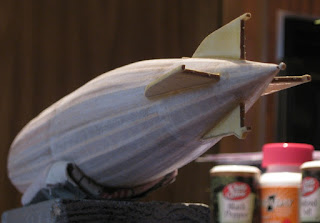Fabrication of the tail fins for this model was pretty straightforward. I pretty much just traced the shape of them off the plan onto the 1/16" stock sheet balsa wood, and cut them out. I then laminated acid free paper to the surfaces of the wood to give a smooth finish, and to strengthen the structural integrity of the fins so they would not break off to easy along the grain lines. Before I glued the fins on the hull, after this, I cut the heads off of straight pins, and shoved the cut off ends into the trailing edge of the fin. I put two pins in each fin. These serve as locator pins for holding the rudders and elevator flaps in place on the back edges of the fins, later.
I added this feature to my model, as you can see in this image below. I realize that I made the fins thicker in relation to the hull than what they actually were in real life. That is because I try to build some durability into my models.
Even though you can't see them yet in these images, I also added the gas shaft hoods, which on the actual ship were used to vent hydrogen out of the gas cells and out of the top of the ship, if it was flying too "light" They were fitted and served in between two gas cells on the ring frames of the hull. They were, for the model fabricated out of balsa wood, and shaped into small thin circular discs. The first two discs are mounted on opposite sides, staggered on the nose, on every other ring, and the remaining discs run right down the very top of the ship on every fourth ring, staggered on either side of the top longitudinal stringer, to the front edge of the upper vertical fin. These pictures showing this will be shown in the next post.
Jim.








No comments:
Post a Comment